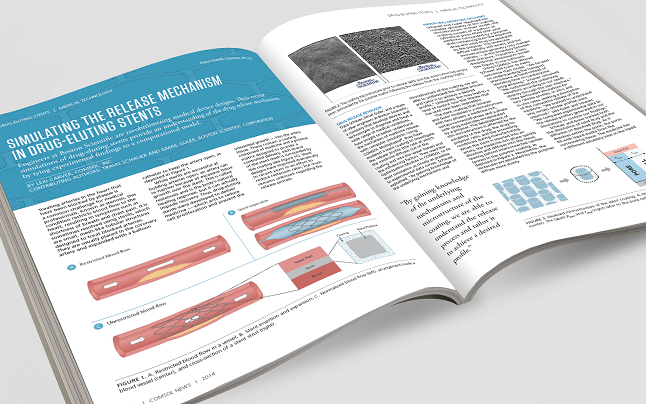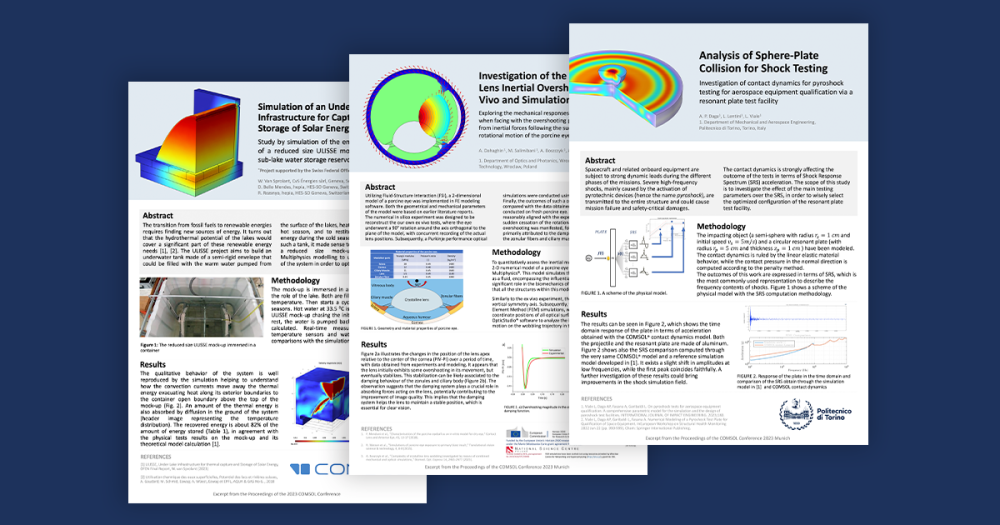
We’re excited to announce that COMSOL News 2014 is now available, which features stories about the cutting-edge research of engineers and scientists working in a variety of application areas around the globe. This year’s edition of the magazine provides insight into how multiphysics simulation can empower product development and help companies to stay ahead of — and create — new market trends. How is this achieved? Check out the magazine to learn more about innovative simulation techniques.
Multiphysics Simulation Throughout the Design Process
When flipping through COMSOL News 2014, one thing that you’ll notice is that multiphysics simulation plays a key role in all aspects of the design process for many firms, from the conceptual phase of product development, until a product is delivered to the market (and even after as new discoveries lead to continuous design improvements). Not only is the use of multiphysics simulation explored throughout many stages of the design process, but also explained by simulation experts is the way that each of these steps are interrelated. In the magazine, you’ll learn how multiphysics simulation, when used throughout the design process, can provide a realistic model that comprises all relevant physics effects, allowing engineers to bring the right product to market on time and within budget.
Innovative Release Mechanisms for Drug-Eluting Stents
For example, multiphysics simulation is employed by engineers at Boston Scientific, who are revolutionizing medical device design by gaining the knowledge required to control the underlying release mechanism of drug-eluting stents. Their goal is to treat the plaque build-up in arteries by using drug-release rates customized to a patient’s individual needs.

Turn to page 10 of COMSOL News 2014 to read the article by Boston Scientific called “Simulating the Release Mechanism in Drug-Eluting Stents”.
Testing Low-Enriched Fuel Types for Nuclear Reactors
Moreover, researchers at Oak Ridge National Laboratory (ORNL) are currently in the conceptual phase of design, where they are testing new low-enriched fuel configurations for the High Flux Isotope Reactor (HFIR), one of the last nuclear reactors in the U.S. using highly-enriched uranium fuel. By utilizing multiphysics simulation and exploring different fuel configurations and fuel plate deflections, ORNL researchers are helping to develop a new HFIR core that will continue to produce the same flux of neutrons while utilizing low-enriched uranium fuel. By testing different conceptual designs, ORNL researchers can ensure that their final design will perform as expected.
Lightning Strike Protection
For engineers at Boeing, multiphysics simulation helped investigate and verify the thermal expansion of composite materials used in metal foil for lightning strike protection on the Boeing 787 Dreamliner (which you can see featured in the cover of COMSOL News 2014). For this innovative jet airliner, comprised of more than 50 percent carbon fiber reinforced plastic, Boeing researchers evaluated the performance of such protective material over time.
Read the Magazine Now
Mentioned here are just a few highlights of the innovative work achieved by engineers and researchers that depend on the power and accuracy of multiphysics simulation. From building physics to tire pressure sensors and lab-on-a-chip devices and robotics, there are many exciting projects featured from many different application areas.
Get the full stories by checking out the magazine online.






Comments (0)